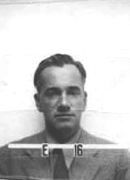Otto Frisch
Otto Robert Frisch (born October 1, 1904 in Vienna , Austria-Hungary ; † September 22, 1979 in Cambridge ) was an Austrian physicist who later fled from the Nazis and became a British citizen.
Life
He was born as the son of the Jewish lawyer and translator Justinian Frisch and the pianist Auguste Frisch nee. Meitner was born. In 1922 he began studying physics at the University of Vienna and received his doctorate in 1926 with a thesis on the effect of the newly discovered electrons on salts. After several years at the Physikalisch-Technische Reichsanstalt in Berlin, he got a job with Otto Stern at the Institute for Physical Chemistry in Hamburg. After Hitler came to power, he emigrated to London in the summer of 1933 to Birkbeck College , where he worked with the physicist Patrick Maynard Stuart Blackett on the technology of the cloud chamber and artificial radioactivity . From 1934 he worked for five years in Copenhagen with Niels Bohr on questions of nuclear physics , in particular neutron physics . In 1936 Bohr was also able to win over the German Hans von Halban from the ETH Zurich to work.

During the Christmas holidays in 1938 at his aunt Lise Meitner's in Kungälv , she received the news that Otto Hahn and Fritz Strassmann had identified the element barium when neutrons collided with uranium atomic nuclei in Berlin . Hahn was initially unable to physically interpret this radiochemical discovery, the evidence of which he published in the journal Die Naturwissenschaften on January 6, 1939 . He had very clearly described the process as a “bursting” of the uranium nucleus. During a famous walk in the snow, Meitner and Frisch found the first physical interpretation for the result of the experiment. They were the first to hypothesize that the uranium atom was split into two parts, ie a “nuclear fission” must have taken place. As Frisch and Meitner correctly estimated at the time, more energy must have been released during this process than any other process can deliver, namely 200 MeV - 200 million electron volts . Frisch was the first to observe the high-energy fragments through a physical experiment on January 13, 1939 in Copenhagen and thus confirmed the nuclear fission in a completely different way. The radiochemical description of the phenomena discovered by Hahn and Strassmann was followed by a separate publication by Meitner and Frisch in "Nature" on February 11, 1939, which explained the physics of nuclear fission behind these observations. Otto Hahn later received the Nobel Prize in Chemistry in 1944 for the radiochemical proof of nuclear fission . In addition, Frisch remarked:
“In my opinion, that is quite correct. The discovery of the fission of uranium [...] was the crucial observation from which everything else had to develop very quickly. "

After a trip from Denmark to England in the summer of 1939, Frisch could not return because of the outbreak of World War II and did research at the University of Birmingham . With the emerging dangers of the Nazi dictatorship, he drafted the Frisch-Peierls memorandum together with the physicist Rudolf Peierls . It is seen as the first theoretical-technical document that describes how an atomic bomb could be constructed using 235 U. This memorandum formed the basis of both the British work to build an atomic bomb ( the Tube Alloys project ) and the Manhattan Project in the USA. In 1943, Frisch worked in the British delegation after receiving British citizenship.
In 1946 he returned to England, where he then headed the nuclear physics department of the Atomic Energy Research Establishment in Harwell. At the same time he spent the next 30 years, until his retirement in 1972, in Cambridge as a “Jacksonian Professor of Natural Philosophy and fellow” at Trinity College . He developed a laser scan process for registering the particle trajectories in bubble chambers (Sweepnik) and since this had other applications, he and colleagues founded Laser Scan in 1969.
His son Tony Frisch was also a physicist.
meaning
- In 1933, together with Otto Stern, he discovered the anomalous magnetic moment of the proton . This was the first indication that this particle is not an elementary particle .
- With his aunt Lise Meitner , he wrote the first theoretical interpretation of nuclear fission in 1939 .
- He created the first theoretical-technical document on the construction of an atom bomb using uranium-235.
Fonts (selection)
- Products of Fission of the Uranium Nucleus. In: Nature. 143, 1939, p. 471 f. (with Lise Meitner).
- Meet the Atom.
- Progress in Nuclear Physics. 4 volumes. 1950-1955.
- Atomic Physics Today. 1961.
- The elementary particles of physics. West German publishing house, Cologne / Opladen 1963.
- Working with Atoms. 1965.
- Profession in Nuclear Physics. 1950-65 (eds.).
-
What Little I Remember. 1979.
- German Edition: What I remember. Physics and physicist of my time. Wissenschaftliche Verlagsgesellschaft, Stuttgart 1981, ISBN 3-8047-0614-2 .
literature
- Mark Walker : Otto Hahn - responsibility and repression . Max Planck Society, Berlin 2003 ( online (PDF; 442 kB) [accessed October 1, 2014] research program “History of the Kaiser Wilhelm Society under National Socialism”, results 10).
Web links
- Literature by and about Otto Frisch in the catalog of the German National Library
- Chronicle of a Discovery. Institute for Nuclear Chemistry at the University of Mainz, accessed on October 1, 2014 .
- Short biography and list of publications. Department of Chemistry at the University of Hamburg, August 30, 2013, accessed on October 1, 2014 .
Individual evidence
| personal data | |
|---|---|
| SURNAME | Fresh, Otto |
| ALTERNATIVE NAMES | Frisch, Otto Robert (full name) |
| BRIEF DESCRIPTION | Austro-British nuclear physicist |
| DATE OF BIRTH | October 1, 1904 |
| PLACE OF BIRTH | Vienna |
| DATE OF DEATH | 22nd September 1979 |
| Place of death | Cambridge |